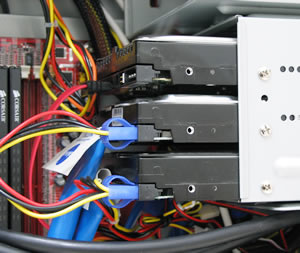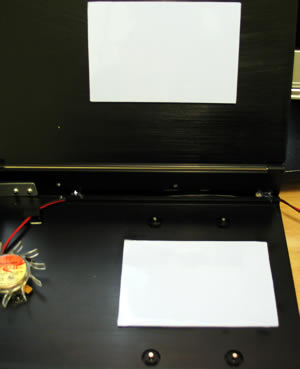1. Introduction
 Thermaltake is one of the better known manufacturers of PC cooling solutions and PC case modding, among other things. Even though the company was founded in the late 90's, 1999 to be specific, it has managed to become one of the top brands in cooling solutions with a range of products that provide cures for "thermal" problems.
Thermaltake is one of the better known manufacturers of PC cooling solutions and PC case modding, among other things. Even though the company was founded in the late 90's, 1999 to be specific, it has managed to become one of the top brands in cooling solutions with a range of products that provide cures for "thermal" problems.
For this review, we received the new HDD cooling solution from Thermaltake, the Hardcano 14, an aluminium case for 3.5" hard discs, with support for a variety of connection interfaces.

Features
- Clamshell design for easy installation
- All aluminium heatsink helps spread and dissipate heat
- Wire mesh promotes better airflow
- Blue mystic LED streamer lights up your system
- Silent and powerful mini 12V pump with excellent reliability
- Fully anti-shock protection, guards your storage system
- Application for 3.5" HDD with IDE, SCSI, SATA, SAS interface
Specifications
| Product name |
HARDCANO 14 ( A2321) |
| Weight |
986g |
| Dimension |
210 x 150 x 44 mm |
| Material |
Aluminium |
| Fan Dimension |
50 x 50 x 10 mm |
| Rated Voltage |
12V |
| Start Voltage |
9V |
| Power Input |
2.88W |
| Rated Current |
0.24A |
| Bearing |
Sleeve |
| Fan Speed |
3000 rpm |
| Max Air Flow |
6.55 CFM |
| Air Pressure |
1.28MM-H2O |
| Noise |
16.0 dBA |
The box...

The retail package we received from Thermaltake includes the Hardcano 14, two thermal pads, four HDD gaskets, four screws and the installation manual.

The following "compact" fan is responsible for maintaining air flow in the Hardcano 14.

We will now move onto detailed information regarding the installation procedure, on the next page...
2. Installation
Before proceeding with the installation procedure, we should add that the Hardcano has another advantage. It essentially adds one more slot for a hard disk on your case, since the case fits in the wide, 5.25" bay where normally your CD and DVD drives go. This was handy in our case where we only had three slots for hard drives and all were occupied. Moreover, all those hard disks so close to one another, amounts to temperature buildup.

Begin by installing the hard disk inside the Hardcano 14's case, a fairly simple task. First, un-screw the two screws on the right side of the case and open the shell (see photos below).
Apply the two thermal pads to the "floor" and "ceiling" of the case (i.e. the top and base of the inside of the shell as shown in the photos below), in the position where the hard disk will be situated.

Peel off the plastic transparent protective strips from each pad.
There are four metallic standoffs on the base of the case which line up with the four mounting holes on the bottom of the hard drive (see photos below). If for some reason, when you close the case, the top of the case does not contact the top of the hard drive, there are rubber pads that can be inserted on the standoffs to raise the hard drive. When properly installed, the top of the hard drive (i.e. the surface with the metal cover and not that with the pcb) should press firmly against the thermal pad on the cover of the Hardcano 14.
 |
 |
Once you have done this, close the shell and replace the two side screws. The hard disk that has just been installed in the Hardcano, contacts only the upper thermal pad for heat dissipation. It does not contact and should not contact the one under the hard drive, on the base of the case, as it can cause damage to the hard disk's pcb. We are not sure why this pad needs to be installed as it doesn't play any role, however, after speaking with Thermaltake, they advised us that it needs to be installed.
Install the Hardcano 14 in your PC case in an empty 5.25" drive bay slot. You then need to provide power to the fan, connect the IDE/SATA.SCSI cable and power to the hard disk.
The result is quite impressive...

...especially when the Hardcano begins operation.

3. Performance
We ran some tests to see if the Hardcano 14 makes any difference in temperature. We used a 200GB Hard Disk from Western Digital with an IDE interface.

We split the disk into two partitions and stored a large file onto the first partition. We then copied this file from the one partition to the other in order to get the hard disk head moving around while it was continually reading and writing. The time needed for the whole file to be copied from the one partition to the other was 8 minutes. We then ceased all access with the hard disk for about 6 minutes, to check how quickly the temperature would decrease. We performed this simple test firstly with the hard disk installed stand-alone in the 3.5" drive bay and then in the Hardcano 14 which was installed in the 5.25" drive bay.
To measure the HD's temperature, we used for one more time, the SpeedFan v4.27 utility which provided us with real time monitoring and created a graph of temperature over time.
 |
| Stand alone hard disk |
 |
| Hard disk installed in the Hardcano 14 |
Looking at the graph, there's a temperature difference of 4° C before we even start, most probably due to the small fan running inside the Hardcano 14. It appears that when the HDD is idle, the Hardcano 14 does its job quite well. As the copying process gets into full swing, the temperature increases steadily. In the case of the HDD installed inside the Hardcano 14, it doesn't go above 34° C, while with the stand alone HDD, it peaks at 35° C. This is not a tremendous difference but don't forget, the whole testing procedure didn't last more than 8 minutes. After the transfer had finished, notice how much quicker the temperature decreases with the Hardcano 14. At the end of the test, the difference was again around 4° C.
We also tried to measure the temperature of the Hard Disk when running common, everyday tasks such as games, DVD-Video ripping, etc, but we saw no significant increase in the hard disk's temperature as we had seen in our transfer test. In this case, the HDD in the Hardcano 14 maintained its 4° C lower temperature from the stand alone HDD. And as we assumed earlier, this is most likely due to the small fan running inside the Hardcano's case.
As for the noise level from the small fan in the Hardcano 14, it was quite low but we cannot confirm if indeed it was 16 dBA as stated in the specifications. It was discernable however and in most cases it may not be noticeable, but if you have a silent, fanless system, it might be.
4. Conclusion
The Hardcano 14 is an impressive HDD cooling case with an excellent finish and good construction. The clamshell design proved to be very convenient and we had no problems at all with the installation. The installation process is straightforward and it took only few minutes for us to install our HDD in the Hardcano 14 case. The aluminium cover acts as a heatsink and with the help of the thermal pads, helps dissipate any heat.
When installed in your PC, it actually looks quite impressive with the wire mesh front and flashing blue LEDs It really adds to the look of any PC case.

The Hardcano 14 will reduce the temperature of your hard disk when compared to a stand alone HDD by a few degrees, resulting hopefully in longer life span. The difference was most noticeable in simple everyday use, where the temperature was 4° C lower with the Hardcano 14. Under heavy, continuous use however, the difference is around 1° C.
The noise levels from the small fan are not noticeable as long as you don't have a silent, fanless system. The actual noise level may be slightly above the specified 16dBA, but it shouldn't bother you.
Apart from heat dissipation which is the primary role for using the Hardcano 14, it also provides an extra position for a hard disk drive by utilising one of the 5.25" drive bay slots. In our case, this was good since our 3.5" drive bay was full :-)
Overall, the Hardcano is a good device.
You'll find it on the e-market for around $28!!!